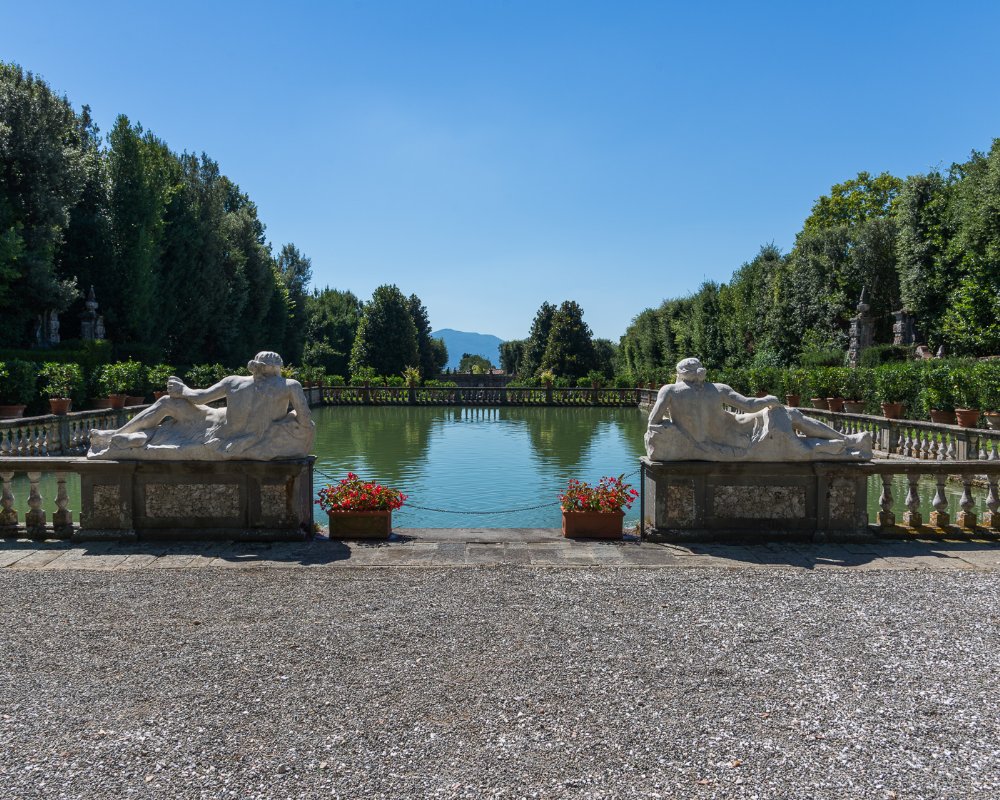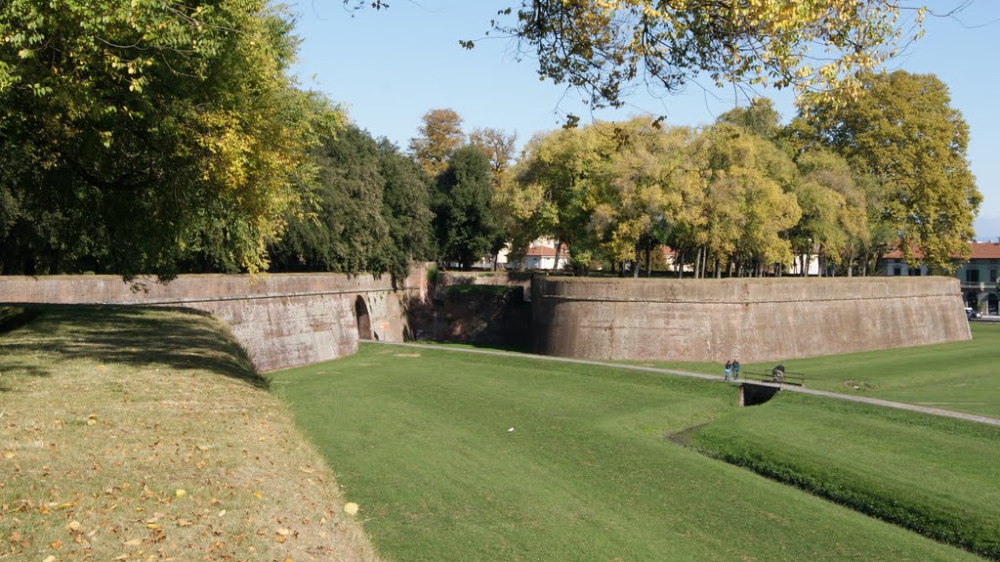From the camellias of Capannori to trailing the Via Francigena to Altopascio, a journey through nature, flavours and history
From remarkable aristocratic villas, secret gardens where the rarest camellias in Italy are in bloom and spas to relax, to villages buried among the hills and vineyards where you can indulge in a glass of wine, or trek the route of the via Francigena. Many are the riches of Lucchesia and the Serchio Valley, two regions that embrace the city of Lucca and are perfect for those dreaming of a slower-paced holiday, which includes artistic and historical treasures but also nature and relaxation.
We recommend this 5-day itinerary, which contains well-known treasures as well as hidden pearls of a land rich with history and traditions, particularly culinary ones.
We begin by discovering Lucca, the splendid fortified city whose majestic surrounding wall remains intact with 10 unspoiled bastions. The walk above the city walls is four kilometres long, immersed in the green landscape, and provides a view of the historic centre from above.
A day in Lucca, also known as the city of the hundred churches, can’t omit its most beautiful cultural sites. Starting from the Cathedral of San Martino, once a place of rest for the pilgrims of the Via Francigena, which preserves within a real treasure: the marvellous statue of Ilaria del Carretto, the princess of Lucca who died young in labour, sculpted in marble by Jacopo della Quercia.
For a quick refreshment break, sample the specialities of Lucca, such as wheat and bean soup, or Buccellato, a dessert rich in anise, raisins and candied fruit which is undeniably typical of the city.
The route carries onto piazza dell’Anfiteatro, which has preserved the circular shape of the ancient Roman amphitheatre on which it was built, and onwards from there to the Basilica of San Frediano, a Romanesque masterpiece with a beautiful mosaic on its façade portraying Christ the Redeemer.
Finally, after a visit to the church of San Michele in Foro, the day ends with a fairy-tale sunset over Torre Guinigi, almost 45 metres tall, whose roof reserves a little surprise: an actual sky garden with seven oak trees.
We begin by discovering Lucca, the splendid fortified city whose majestic surrounding wall remains intact with 10 unspoiled bastions. The walk above the city walls is four kilometres long, immersed in the green landscape, and provides a view of the historic centre from above.
A day in Lucca, also known as the city of the hundred churches, can’t omit its most beautiful cultural sites. Starting from the Cathedral of San Martino, once a place of rest for the pilgrims of the Via Francigena, which preserves within a real treasure: the marvellous statue of Ilaria del Carretto, the princess of Lucca who died young in labour, sculpted in marble by Jacopo della Quercia.
For a quick refreshment break, sample the specialities of Lucca, such as wheat and bean soup, or Buccellato, a dessert rich in anise, raisins and candied fruit which is undeniably typical of the city.
The route carries onto piazza dell’Anfiteatro, which has preserved the circular shape of the ancient Roman amphitheatre on which it was built, and onwards from there to the Basilica of San Frediano, a Romanesque masterpiece with a beautiful mosaic on its façade portraying Christ the Redeemer.
Finally, after a visit to the church of San Michele in Foro, the day ends with a fairy-tale sunset over Torre Guinigi, almost 45 metres tall, whose roof reserves a little surprise: an actual sky garden with seven oak trees.
We shift to the countryside to discover some of the most beautiful villas of the Lucchesia, located in Capannori.
We begin with the Villa Reale di Marlia, belonging to Elisa Baciocchi, Napoleon’s sister and Lady of Lucca, and later Tuscany. It was she who is responsible for the villa’s current appearance, making changes to it in the 19th century. With an impressive sixteen-acre park, it is the site of the famous Theatre of Verzura, installed in 1652 with yew hedges, where even Paganini once performed, as well as its Italian garden and the lemon grove, with over 200 vases of citrus fruits.
The Villa Torrigiani is an unmissable sight, located in the village of Camigliano. It is a luxurious sixteenth-century building, inspired by the palace of Versailles, with spectacular ornamental water features, grottos and camellia gardens.
The camellias haven been cultivated in Lucchesia since the eighteenth-century by noble families, therefore, the land is still rich with hundred of varieties, even the rarest ones. In particular, the towns of Pieve and Sant’Andrea di Compito, in the municipality of Capannori, are part of the hamlet of the camellias. Here you can admire many specimens of camellia of various colours and shades, and visit the Camellietum Compitese, a unique garden in Italy accessible only with pre-booking and in occasion of the Exhibition of Ancient Camellias of Lucchesia, which takes place in March.
We shift to the countryside to discover some of the most beautiful villas of the Lucchesia, located in Capannori.
We begin with the Villa Reale di Marlia, belonging to Elisa Baciocchi, Napoleon’s sister and Lady of Lucca, and later Tuscany. It was she who is responsible for the villa’s current appearance, making changes to it in the 19th century. With an impressive sixteen-acre park, it is the site of the famous Theatre of Verzura, installed in 1652 with yew hedges, where even Paganini once performed, as well as its Italian garden and the lemon grove, with over 200 vases of citrus fruits.
The Villa Torrigiani is an unmissable sight, located in the village of Camigliano. It is a luxurious sixteenth-century building, inspired by the palace of Versailles, with spectacular ornamental water features, grottos and camellia gardens.
The camellias haven been cultivated in Lucchesia since the eighteenth-century by noble families, therefore, the land is still rich with hundred of varieties, even the rarest ones. In particular, the towns of Pieve and Sant’Andrea di Compito, in the municipality of Capannori, are part of the hamlet of the camellias. Here you can admire many specimens of camellia of various colours and shades, and visit the Camellietum Compitese, a unique garden in Italy accessible only with pre-booking and in occasion of the Exhibition of Ancient Camellias of Lucchesia, which takes place in March.
The third day is dedicated to discovering and tasting a unique corner of Lucchesia’s hills: the splendid village of Montecarlo, awarded by the Touring Club with the Orange Flag, the seal for high quality environmentalism and tourism. The town is sheltered on the peak of a hill which dominates the valley, immersed between olive groves and vineyards where they farm the renowned Montecarlo DOC, which can be both a white and red wine.
Here you can walk down the village’s alleys and taste an excellent glass of wine during a guided tour of the farms and the local viniculture firms, or take a seat at a wine shop. This is also the perfect opportunity to taste traditional dishes from Lucca, such as rabbit stew or farinata with borlotti beans and cavolo nero, without forgetting the Torta co’becchi, a shortcrust pastry filled with spices and sweet herbs.
The third day is dedicated to discovering and tasting a unique corner of Lucchesia’s hills: the splendid village of Montecarlo, awarded by the Touring Club with the Orange Flag, the seal for high quality environmentalism and tourism. The town is sheltered on the peak of a hill which dominates the valley, immersed between olive groves and vineyards where they farm the renowned Montecarlo DOC, which can be both a white and red wine.
Here you can walk down the village’s alleys and taste an excellent glass of wine during a guided tour of the farms and the local viniculture firms, or take a seat at a wine shop. This is also the perfect opportunity to taste traditional dishes from Lucca, such as rabbit stew or farinata with borlotti beans and cavolo nero, without forgetting the Torta co’becchi, a shortcrust pastry filled with spices and sweet herbs.
The fourth day is a lesson in relaxation at the spas of Bagni di Lucca, the village in the Serchio Valley famous since the Roman period for its thermal and healing springs which in the nineteenth century were frequented by nobles and artists from all of Europe, including Byron, Shelley, Strauss, Dumas and many others.
To reach it we pass by Borgo a Mozzano, where you can admire the Ponte della Maddalena, nicknamed the Devil’s Bridge, renowned for its unique profile, with its rounded arch flanked by three smaller arches, and which according to local legend was built by Satan himself.
At the spas of Bagni di Lucca you can regenerate yourself in two thermal complexes, Jean Varraud and Casa Boccella; immerse yourself in the warm pools; indulge in treatments and massages at the Ouida wellbeing centre; and purify yourself in two wonderful natural caves: Grotta Grande and Grotta Paolina, where the steam is beneficial to both skin and circulation.
The fourth day is a lesson in relaxation at the spas of Bagni di Lucca, the village in the Serchio Valley famous since the Roman period for its thermal and healing springs which in the nineteenth century were frequented by nobles and artists from all of Europe, including Byron, Shelley, Strauss, Dumas and many others.
To reach it we pass by Borgo a Mozzano, where you can admire the Ponte della Maddalena, nicknamed the Devil’s Bridge, renowned for its unique profile, with its rounded arch flanked by three smaller arches, and which according to local legend was built by Satan himself.
At the spas of Bagni di Lucca you can regenerate yourself in two thermal complexes, Jean Varraud and Casa Boccella; immerse yourself in the warm pools; indulge in treatments and massages at the Ouida wellbeing centre; and purify yourself in two wonderful natural caves: Grotta Grande and Grotta Paolina, where the steam is beneficial to both skin and circulation.
Every year the number of hikers that trail the via Francigena keeps on growing. The pilgrims’ road, which in the Middle Ages connected Canterbury to Rome, is now a fascinating route through history and nature crossing the whole of Tuscany.
The via Francigena even passed through Lucca before carrying on to Altopascio, which in the first millennium was the hospital of the Knights of the Tau, who welcomed the pilgrims. Today you can visit the Church of San Jacopo, originally the knights’ headquarters, which preserves a splendid Romanesque gate and gable. Inside, you can admire a fresco portraying San Jacopo with a pilgrim’s stick and shell on his chest.
The journey ends with a lunch based in local delicacies, among which you can’t be forget the celebrated Altopascio bread, produced without yeast, making it soft on the inside with a hard crust, accompanied by a cured meat from Lucca, such as Biroldo. For dessert you can’t miss the Castagnaccio, made using chestnut flour from the Garfagnana.
Every year the number of hikers that trail the via Francigena keeps on growing. The pilgrims’ road, which in the Middle Ages connected Canterbury to Rome, is now a fascinating route through history and nature crossing the whole of Tuscany.
The via Francigena even passed through Lucca before carrying on to Altopascio, which in the first millennium was the hospital of the Knights of the Tau, who welcomed the pilgrims. Today you can visit the Church of San Jacopo, originally the knights’ headquarters, which preserves a splendid Romanesque gate and gable. Inside, you can admire a fresco portraying San Jacopo with a pilgrim’s stick and shell on his chest.
The journey ends with a lunch based in local delicacies, among which you can’t be forget the celebrated Altopascio bread, produced without yeast, making it soft on the inside with a hard crust, accompanied by a cured meat from Lucca, such as Biroldo. For dessert you can’t miss the Castagnaccio, made using chestnut flour from the Garfagnana.


